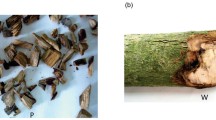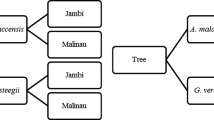Abstract
Agarwood is broadly used in incense and medicine. Traditionally, agarwood formation is induced by wounding the trunks and branches of some species of Aquilaria spp., including A. sinensis. As recently evidenced, some fungi or their fermentation liquid may have the potential of inducing agarwood formation. The present study aimed to analyze the fungi isolated from an agarwood-producing A. sinensis tree and subsequently identify the fungi capable of promoting agarwood formation. We identified a total of 110 fungi isolates based on their morphological characteristics and rDNA ITS sequences. These isolates came from four different layers (namely the decomposing layer, agarwood layer, transition layer, and normal layer) near the agarwood formation site of the trunk. According to the experimental results, most of them belonged to Dothideomycetes (81.82%), while the others to Sordariomycetes (13.64%) or Eurotiomycetes (4.55%). Of note, 88 isolates were shown belonging to the species of Lasiodiplodia theobromae that are most frequently isolated from different layers. In addition, when the fermentation liquid of two isolates of L. theobromae (AF4 and AF12) and one isolate of Fusarium solani (AF21) was inoculated into the A. sinensis wood using the Agar-Wit technique, promoted agarwood formation was observed; however, the effect of AF21 did not keep stable in the later test, while AF4 and AF12 still functioned 1 year later. This study may lay a foundation for exploring the underlying mechanism of agarwood formation as well as fungi application in agarwood production.



Similar content being viewed by others
References
Aldridge DC, Galt S, Giles D, Turner WB (1971) Metabolites of Lasiodiplodia theobromae. J Chem Soc C 1623–1627
Alves A, Crous PW, Correia A, Phillips AJL (2008) Morphological and molecular data reveal cryptic speciation in Lasiodiplodia theobromae. Fungal Divers 28:1–13
Blanchette RA, Heuveling VBH Cultivated agarwood. EU: W002094002, 2001
Bose SR (1934) The nature of agar formation. Sci Cult 4:89–91
Bose SR (1939) Enzymes of wood-rotting fungi. Ergeb Enzymforsch 8:267–276
Cardoso JE, Vidal JC, Santos AA, Freire FCO, Viana FMP (2002) First report of black branch dieback of cashew caused by Lasiodiplodia theobromae in Brazil. Plant Dis 86:558
Çeliker NM, Michailides TJ (2012) First report of Lasiodiplodia theobromae causing canker and shoot blight of fig in Turkey. New Dis Rep 25:12
CITES (2005) The use and trade of agarwood in Japan. http://www.cites.org/common/com/PC/15/X-PC15-06-Inf.pdf
CITES (2005) The trade and use of agarwood in Taiwan, Province of China. http://www.cites.org/common/com/pc/15/x-pc15-07-inf.pdf
Dobranic JK, Johnson JA, Alikhan QR (1995) Isolation of endophytic fungi from eastern larch (Larix laricina) leaves from New Brunswick, Canada. Can J Microbiol l41:194–198
Eurlings MCM, Gravendeel B (2005) TrnL-trnF sequence data imply paraphyly of Aquilaria and Gyrinops (Thymelaeaceae) and provide new perspectives for agarwood identification. Pl Syst Evol 254:1–12
Feng NX (2008) Preliminary study on endophytic fungi in Aquilaria sinensis. Nanchang University, Jiangxi, China, Master thesis
Gibson IAS (1977) The role of fungi in the origin of oleoresin deposits (agaru) in the wood of Aquilaria agallocha Roxb. Bano Biggyan Patrika 6:16–26
Gong LJ, Guo SX (2009) Endophytic fungi from Dracaena cambodiana and Aquilaria sinensis and their antimicrobial activity. Afr J Biotechnol 8:731–736
Guangdong Institute of Botany (1976) Preliminary disclosure secret of agarwood formation of Aquilaria sp. Acta Botanica Sinica 18:287–290
Gunn B, Stevens P, Singadan M, Sunari L, Chatterton P (2003) Eaglewood in Papua New Guinea. Resource Management in Asia-Pacific Working Paper No. 51, Publisher: Resource Management in Asia-Pacific Program, Research School of Pacific and Asian Studies, the Australian National University, Canberra ISSN–1444-187X
Han XM, Liang L, Zhang Z, Li XJ, Yang Y, Meng H, Gao ZH, Xu YH (2014) Study of production of sesquiterpenes of Aquilaria sinensis stimulated by Lasiodiplodia theobromae. Chin J Chin Mater Med 39:192–196
Ito M, Gisho H (2005) Taxonomical identification of agarwood-producing species. Nat Med 59:104–112
Ito M, Okimoto K, Yagura T, Honda G (2005) Induction of sesquiterpenoid production by methyl jasmonate in Aquilaria sinensis cell suspension culture. J Essent Oil Res 17:175–180
Krasnobajew V, Helmlinger D (1982) Fermentation of fragrances: biotransformation of β-ionone by Lasiodiplodia theobromae. Helv Chim Acta 65:1590–1601
Kumeta Y, Ito M (2010) Characterization of δ-guaiene synthases from cultured cells of Aquilaria, responsible for the formation of the sesquiterpenes in agarwood. Plant Physiol 154:1998–2007
Latha P, Prakasam V, Kamalakannan A, Gopalakrishnan C, Raguchander T, Paramathma M, Samiyappan R (2009) First report of Lasiodiplodia theobromae (Pat.) Griffon & Maubl causing root rot and collar rot disease of physic nut (Jatropha curcas L.) in India. Australas Plant Dis Notes 4:19–20
Liao YC (2015) Moleular mechanism of JA signaling pathway involved in the regulation of agarwood sesquiterpene biosynthesis. Chinese Academy of Medical Sciences & Peking Union Medical College, Beijing, China, Ph. D. Dissertation
Liu YY, Chen HQ, Yang Y, Zhang Z, Wei JH, Meng H, Chen WP, Feng JD, Gan BC, Chen XY, Gao ZH, Huang JQ, Chen B, Chen HJ (2013) Whole-tree agarwood-inducing technique: an efficient novel technique for producing high-quality agarwood in cultivated Aquilaria sinensis trees. Molecules 18:3086–3106
Matsuura H, Nakamori K, Omer EA, Hatakeyama C (1998) Three lasiodiplodins from Lasiodiplodia theobromae ifo 31059. Phytochemistry 49:579–584
Mohamed R, Jong PL, Kamziah AK (2014) Fungal inoculation induces agarwood in young Aquilaria malaccensis trees in the nursery. J For Res 25:201–204
Mohamed R, Jong PL, Zali MS (2010) Fungal diversity in wounded stems of Aquilaria malaccensis. Fungal Div 43:67–74
Ng LT, Chang YS, Kadir AA (1997) A review on agar (gaharu) producing Aquilaria species. J Trop For Prod 2:272–285
Nobuchi T, Somkid S (1991) Preliminary observation of Aquliaria crassna wood associated with the formation of aloeswood. Kyoto Univ For 63:226–235
Persoon GA, van Beek HH (2008) Growing “the wood of the Gods”. In: Snelder DJ, Lasco RD (eds) agarwood production in Southeast Asia. Springer, Dordrecht, Chap 5
Pojanagaroon S, Kaewrak C (2006) Mechanical methods to stimulate aloes wood formation in Aquiliria crassna Pierre ex H Lec (kritsana) trees. ISHS Acta Hort 676:161–166
Premalatha K, Kalra A (2013) Molecular phylogenetic identification of endophytic fungi isolated from resinous and healthy wood of Aquilaria malaccensis, a red listed and highly exploited medicinal tree. Fungal Ecol 6:205–211
Qi SY, He ML, Lin LD, Zhang CH, Hu LJ, Zhang HZ (2005) Production of 2-(2-phenyl–ethyl) chromones in cell suspension cultures of Aquilaria sinensis. Plant Cell Tissue Org Cult 11:217–221
Qi SY, Lin LD, Ye QF (1998) Benzylacetone in agarwood and its biotransformation by melanotus flavolivens. Chin J Biotechnol 14:464–466
Qi SY, Lu BY, Zhu LF, Li BL (1992) Formation of oxo-agarospirol in Aquilaria sinensis. Plant Physiol Comm 28:336–339
Rahman MA, Basak AC (1980) Agar production in agar trees by artificial inoculation and wounding. Bano Bigan Patrika 9:87–93
Roux J, Coutinho TA, Byabashaija DM, Wingfield MJ (2001) Diseases of plantation Eucalyptus in Uganda. S Afr J Sci 97:16–18
Shah MD, Verma KS, Singh K, Kaur R (2010) Morphological, pathological and molecular variability in Botryodiplodia theobromae (Botryosphaeriaceae) isolates associated with die-back and bark canker of pear trees in Punjab, India. Genet Mol Res 9:1217–1228
Subeham JU, Fujino H, Attamimi F, Kadota S (2005) A field survey of agarwood in Indonesia. J Trad Med 22:244–251
Tamuli P, Boruah P, Nath SC, Leclercq P (2005) Essential oil of eaglewood tree: a product of pathogenesis. J Essent Oil Res 17:601–604
Tamuli P, Boruah P, Nath SC, Samanta R (2000) Fungi from diseased agarwood tree (Aquilaria agallocha Roxb.): two new records. Adv For Res India 22:182–187
Wang L, Zhang WM, Pan QL, Li HH, Tao MH, Gao XX (2009) Isolation and molecular identification of endophytic fungi from Aquilaria sinensis. J Fungal Res 7:37–42
Wei JH, Zhang Z, Yang Y, Meng H, Feng JD, Gan BC (2010) Production of agarwood in Aquilaria sinensis trees via transfusion technique. CN101755629B
Wei JH, Zhang Z, Yang Y, Meng H, Gao ZH, Chen WP, Feng JD, Chen HQ (2009) A kind of agarwood inducer and its production method. ZL 2009 1 0241212.8
Xu WN (2011) Evaluation on key technology of fungi infection induced aloes-forming effect and preliminary research on the mechanism of the eaglewood formation. Guangdong Pharmaceutical University, Guangdong, China, Master thesis
Xu YH, Zhang Z, Wang MX, Wei JH, Chen HJ, Gao ZH, Sui C, Luo HM, Zhang XL, Yang Y, Meng H, Li WL (2013) Identification of genes related to agarwood formation: transcriptome analysis of healthy and wounded tissues of Aquilaria sinensis. BMC Genom 14:227
Yang Q, Asai M, Matsuura H, Yoshihara T (2000) Potato micro-tuber inducing hydroxylasiodiplodins from Lasiodiplodia theobromae. Phytochemistry 54:489–494
Zhang XH, Mei WL, Chen P, Deng YY, Dai HF (2009) Isolation, identification and antimicrobial activity of endophytic fungi in Aquilaria sinensis (Lour.) Gilg. J Microbiol 29:6–10
Zhang XL, Liu YY, Wei JH, Yang Y, Zhang Z, Huang JQ, Chen HQ, Liu YJ (2012) Production of high-quality agarwood in Aquilaria sinensis trees via whole-tree agarwood-induction technology. Chin Chem Lett 23:727–730
Zhang Z, Han XM, Wei JH, Xue J, Yang Y, Liang L, Li XJ, Guo QM, Xu YH, Gao ZH (2014) Compositions and antifungal activities of essential oils from agarwood of Aquilaria sinensis (Lour.) Gilg induced by Lasiodiplodia theobromae (Pat.) Griffon. & Maubl. J Braz Chem Soc 25:20–26
Zhang Z, Wei JH, Han XM, Liang L, Yang Y, Meng H, Xu YH, Gao ZH (2014) The sesquiterpene biosynthesis and vessel-occlusion formation in stems of Aquilaria sinensis (Lour.) Gilg trees induced by wounding treatments without variation of microbial communities. Int J Mol Sci 15:23589–23603
Zhang Z, Yang Y, Wei JH, Meng H, Sui C, Chen HQ (2010) Advances in studies on mechanism of agarwood formation in Aquilaria sinensis and its hypothesis of agarwood formation induced by defense response. Chin Trad Herbal Drugs 41:156–159
Acknowledgements
This research was supported by the National Natural Science Foundation of China (Nos. 81303312 and 81403055), Science & Technology Program of Hainan Province (Nos. ZDXM2015059 and ZDZX2013013), Central Research Institutes of Basic research and Public Service Special Operations (No. 2013HNB01), and Natural Science Foundation of Hainan Province (No. 314183).
Author information
Authors and Affiliations
Corresponding author
Ethics declarations
Conflict of interest
The authors declare that they have no conflict of interest.
Rights and permissions
About this article
Cite this article
Chen, X., Sui, C., Liu, Y. et al. Agarwood Formation Induced by Fermentation Liquid of Lasiodiplodia theobromae, the Dominating Fungus in Wounded Wood of Aquilaria sinensis . Curr Microbiol 74, 460–468 (2017). https://doi.org/10.1007/s00284-016-1193-7
Received:
Accepted:
Published:
Issue Date:
DOI: https://doi.org/10.1007/s00284-016-1193-7




